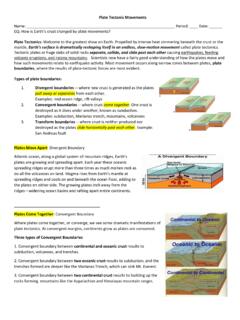Transcription of Cybernetics and Second-Order Cybernetics
1 In: Meyers (ed.), Encyclopedia of Physical Science & Technology (3rd ed.), (Academic Press, New York,2001). Cybernetics and second -OrderCyberneticsFrancis HeylighenFree University of BrusselsCliff JoslynLos Alamos National Development of 1B . second order 4II. Relational and 5B .Variety and and 8B . 9C . 11IV. Goal-Directedness and 12B .Mechanisms of 13C .The Law of Requisite of a Control 17V.
2 18B .The Modelling and 23 GlossaryVariety: a measure of the number of possible states or actionsEntropy: a probabilistic measure of varietySelf-organization: the spontaneous reduction of entropy in a dynamic systemControl: maintenance of a goal by active compensation of perturbationsModel: a representation of processes in the world that allows predictions2 Constructivism: the philosophy that models are not passive reflections of reality, but activeconstructions by the subjectCybernetics is the science that studies the abstract principles of organization in complexsystems.
3 It is concerned not so much with what systems consist of, but how they focuses on how systems use information, models, and control actions to steertowards and maintain their goals, while counteracting various disturbances. Being inherentlytransdisciplinary, cybernetic reasoning can be applied to understand, model and designsystems of any kind: physical, technological, biological, ecological, psychological, social, orany combination of those. Second-Order Cybernetics in particular studies the role of the(human) observer in the construction of models of systems and other Development of from the Greek kybernetes, or "steersman", the term " Cybernetics " first appears inAntiquity with Plato, and in the 19th century with Amp re, who both saw it as the science ofeffective government. The concept was revived and elaborated by the mathematician NorbertWiener in his seminal 1948 book, whose title defined it as " Cybernetics , or the study ofcontrol and communication in the animal and the machine".
4 Inspired by wartime and pre-warresults in mechanical control systems such as servomechanisms and artillery targetingsystems, and the contemporaneous development of a mathematical theory of communication(or information) by Claude Shannon, Wiener set out to develop a general theory oforganizational and control relations in Theory, Control Theory and Control Systems Engineering have since developedinto independent disciplines. What distinguishes Cybernetics is its emphasis on control andcommunication not only in engineered, artificial systems, but also in evolved, natural systemssuch as organisms and societies, which set their own goals, rather than being controlled bytheir as a specific field grew out of a series of interdisciplinary meetings held from1944 to 1953 that brought together a number of noted post-war intellectuals, includingWiener, John von Neumann, Warren McCulloch, Claude Shannon, Heinz von Foerster, Ashby, Gregory Bateson and Margaret Mead.
5 Hosted by the Josiah Macy , these became known as the Macy Conferences on Cybernetics . From its originalfocus on machines and animals, Cybernetics quickly broadened to encompass minds ( in thework of Bateson and Ashby) and social systems ( Stafford Beer's managementcybernetics), thus recovering Plato's original focus on the control relations in the 1950s, cybernetic thinkers came to cohere with the school of General SystemsTheory (GST), founded at about the same time by Ludwig von Bertalanffy, as an attempt tobuild a unified science by uncovering the common principles that govern open, evolvingsystems. GST studies systems at all levels of generality, whereas Cybernetics focuses morespecifically on goal-directed, functional systems which have some form of control there remain arguments over the relative scope of these domains, each can be seen aspart of an overall attempt to forge a transdisciplinary "Systems Science".
6 Perhaps the most fundamental contribution of Cybernetics is its explanation of purposiveness,or goal-directed behavior, an essential characteristic of mind and life, in terms of control andinformation. Negative feedback control loops which try to achieve and maintain goal stateswere seen as basic models for the autonomy characteristic of organisms: their behavior, whilepurposeful, is not strictly determined by either environmental influences or internal dynamicalprocesses. They are in some sense "independent actors" with a "free will". Thus cyberneticsforesaw much current work in robotics and autonomous agents. Indeed, in the popular mind,"cyborgs" and " Cybernetics " are just fancy terms for "robots" and "robotics". Given thetechnological advances of the post-war period, early cyberneticians were eager to explore thesimilarities between technological and biological systems. Armed with a theory of information,early digital circuits, and Boolean logic, it was unavoidable that they would hypothesizedigital systems as models of brains, and information as the "mind" to the machine's "body".
7 More generally, Cybernetics had a crucial influence on the birth of various modern sciences:control theory, computer science, information theory, automata theory, artificial intelligenceand artificial neural networks, cognitive science, computer modeling and simulation science,dynamical systems, and artificial life. Many concepts central to these fields, such ascomplexity, self-organization, self-reproduction, autonomy, networks, connectionism, andadaptation, were first explored by cyberneticians during the 1940's and 1950's. Examplesinclude von Neumann's computer architectures, game theory, and cellular automata; Ashby'sand von Foerster's analysis of self-organization; Braitenberg's autonomous robots; andMcCulloch's artificial neural nets, perceptrons, and order CyberneticsCybernetics had from the beginning been interested in the similarities between autonomous,living systems and machines. In this post-war era, the fascination with the new control andcomputer technologies tended to focus attention on the engineering approach, where it is thesystem designer who determines what the system will do.
8 However, after the controlengineering and computer science disciplines had become fully independent, the remainingcyberneticists felt the need to clearly distinguish themselves from these more mechanisticapproaches, by emphasizing autonomy, self-organization, cognition, and the role of theobserver in modelling a system. In the early 1970's this movement became known as Second-Order began with the recognition that all our knowledge of systems is mediated by oursimplified representations or models of them, which necessarily ignore those aspects ofthe system which are irrelevant to the purposes for which the model is constructed. Thus theproperties of the systems themselves must be distinguished from those of their models, whichdepend on us as their creators. An engineer working with a mechanical system, on the otherhand, almost always know its internal structure and behavior to a high degree of accuracy, andtherefore tends to de-emphasize the system/model distinction, acting as if the model is , such an engineer, scientist, or "first- order " cyberneticist, will study a system as ifit were a passive, objectively given "thing", that can be freely observed, manipulated, andtaken apart.
9 A Second-Order cyberneticist working with an organism or social system, on the4other hand, recognizes that system as an agent in its own right, interacting with another agent,the observer. As quantum mechanics has taught us, observer and observed cannot beseparated, and the result of observations will depend on their interaction. The observer too isa cybernetic system, trying to construct a model of another cybernetic system. To understandthis process, we need a " Cybernetics of Cybernetics ", a "meta" or " Second-Order " cyberneticians' emphasis on such epistemological, psychological and social issues was awelcome complement to the reductionist climate which followed on the great progress inscience and engineering of the day. However, it may have led them to overemphasize thenovelty of their " Second-Order " approach. First, it must be noted that most founding fathersof Cybernetics , such as Ashby, McCulloch and Bateson, explicitly or implicitly agreed withthe importance of autonomy, self-organization and the subjectivity of modelling.
10 Therefore,they can hardly be portrayed as "first order " reductionists. second , the intellectual standardbearers of the second order approach during the 1970's, such as von Foerster, Pask, andMaturana, were themselves directly involved in the development of "first order " cyberneticsin the 1950's and 1960's. In fact, if we look more closely at the history of the field, we see acontinuous development towards a stronger focus on autonomy and the role of the observer,rather than a clean break between generations or approaches. Finally, the second orderperspective is now firmly ingrained in the foundations of Cybernetics overall. For thosereasons, the present article will discuss the basic concepts and principles of Cybernetics as awhole, without explicitly distinguishing between "first order " and " second order " ideas, andintroduce cybernetic concepts through a series of models of classes of must further be noted that the sometimes ideological fervor driving the second -ordermovement may have led a bridge too far.



